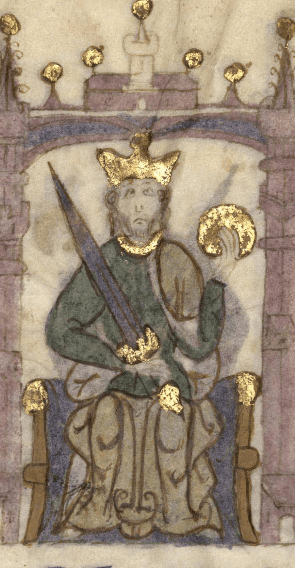García Sánchez III of Pamplona facts for kids
Quick facts for kids García Sánchez III |
|
|---|---|

Late medieval representation of García Sánchez III
|
|
| King of Pamplona, later King of Navarre | |
| Reign | 1035–1054 |
| Predecessor | Sancho III |
| Successor | Sancho IV |
| Born | c. 1012 Nájera, Kingdom of Pamplona |
| Died | 1 September 1054 Atapuerca, County of Castile |
| Burial | Monastery of Santa María la Real of Nájera |
| Consort | Stephanie |
| Issue more... |
|
| House | Jiménez |
| Father | Sancho III of Pamplona |
| Mother | Muniadona of Castile |
García Sánchez III (born around 1012 – died September 1, 1054) was a very important king of Pamplona. He was often called García from Nájera because he was born there. He ruled as King of Pamplona from 1034 until his death.
García Sánchez III was the oldest son of King Sancho III. When his father died, García inherited the main kingdom of Pamplona. He also became the feudal overlord (a kind of boss or protector) over some of his brothers. For example, his brother Ramiro received lands that later became the Kingdom of Aragón. His brother Gonzalo received the areas of Sobrarbe and Ribagorza.
García also had some control over his brother Ferdinand. Ferdinand was the Count of Castile, which was usually part of the Kingdom of León. However, their father, Sancho III, had brought it under his own control.
Contents
Becoming King of Pamplona
García Sánchez III became King of Pamplona in 1035 after his father, Sancho III, passed away. Even though his half-brother Ramiro was older, García was the legitimate heir.
In 1043, García fought against his half-brother Ramiro. García won the battle, which helped set the eastern border of his kingdom.
Expanding the Kingdom
García Sánchez III was a smart ruler. He took advantage of the weaker state of the many small Islamic kingdoms in the south. These kingdoms had formed after a larger Islamic empire broke apart.
By pushing south, García expanded his kingdom's borders. He successfully captured the city of Calahorra in 1045.
He also inherited other lands from his father. These included the County of Álava and a large part of the County of Castile. These areas included places like La Bureba, Trasmiera, and Montes de Oca.
Battles and Challenges
In 1037, García joined his brother Ferdinand in a battle against the Kingdom of León. This battle took place near the Pisuerga river and is known as the Battle of Tamarón.
During this battle, Bermudo III, the King of León, was defeated and killed. This event ended a long line of kings in León. After the victory, Ferdinand was crowned King of León.
However, the relationship between García and Ferdinand became difficult. They disagreed about how to divide the lands of Castile between León and Pamplona. This disagreement led to another battle, the Battle of Atapuerca. Sadly, García Sánchez III died during this battle in 1054.
Family Life
García Sánchez III married Stephanie of Foix in Barcelona in 1038. Stephanie was the youngest daughter of either Bernard-Roger, Count of Bigorre, or Berenguer Ramon I, Count of Barcelona.
They had nine children together:
- Sancho Garcés, who became King of Pamplona as Sancho IV after his father's death. He ruled from 1054 to 1076.
- Urraca Garcés, who married García Ordóñez.
- Ermesinda Garcés, who married Fortún Sánchez.
- Ramiro Garcés, who became the lord of Calahorra.
- Fernando Garcés, who was lord of several towns.
- Ramón Garcés, who was lord of Murillo and Agoncillo.
- Jimena Garcés, who was lady of Corcuetos and other places.
- Mayor Garcés, who was lady of Yanguas.
- Sancha Garcés
García Sánchez also had two children born outside of marriage:
- Sancho Garcés, who was lord of Uncastillo. His grandson, García Ramírez, later became King of Pamplona.
- Mencía Garcés, who married Fortún Ochoiz.
| Preceded by Sancho III as King of Pamplona |
King of Navarre 1035–1054 |
Succeeded by Sancho IV |
See also
 In Spanish: García Sánchez III de Pamplona para niños
In Spanish: García Sánchez III de Pamplona para niños

